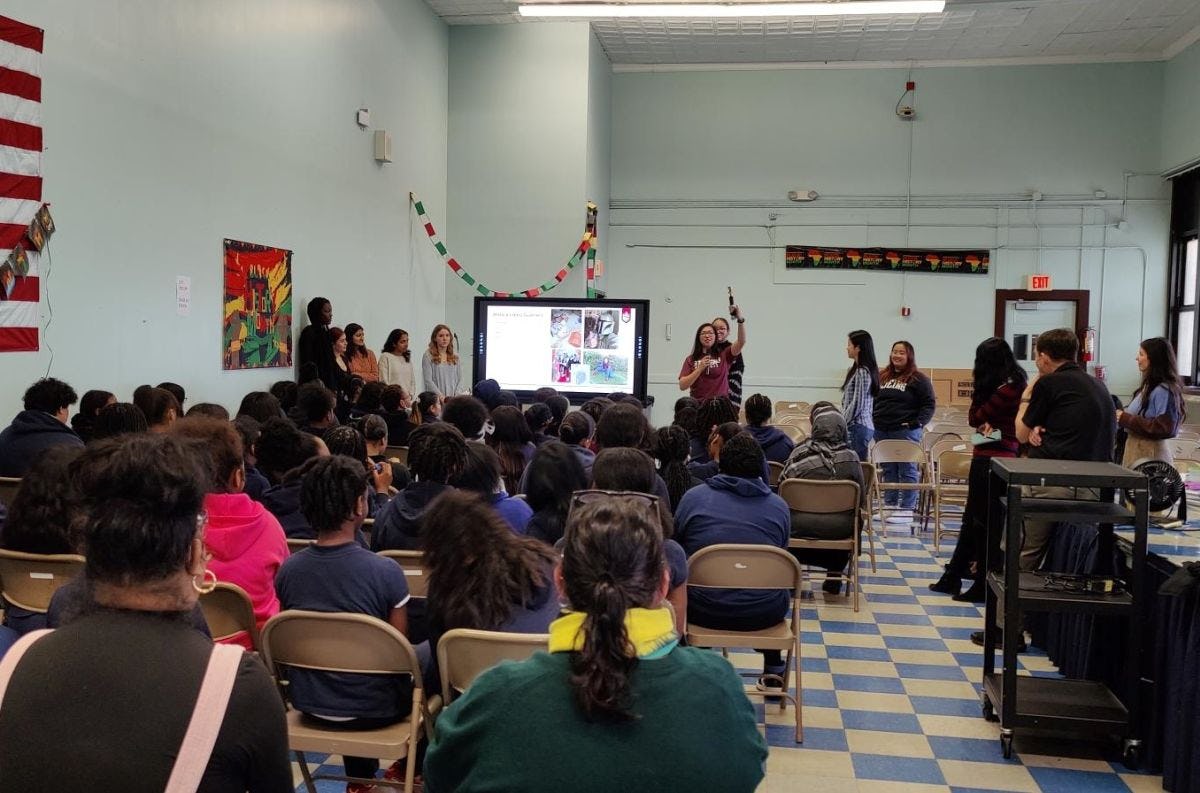Stevens Faculty and Students Engage Curious Young Minds at Introduce a Girl to Engineering! Day
Mentoring girls today can help accelerate the closing of the gender gap in engineering tomorrow
How long does it take to build an airplane?
How do you solve big problems?
These are just some of the questions that curious young minds from the Barack Obama Community School in Jersey City asked during Stevens Institute of Technology’s 8th Annual Introduce a Girl to Engineering! Day. The event, themed, “Creating the Future,” took place in the school’s auditorium last month, and was attended by over 70 girls.
Introduce a Girl to Engineering! Day is part of a nationwide initiative to encourage girls to pursue engineering careers, with the ultimate aim of closing the gender gap in engineering.
Nearly half of the U.S. workforce are women. Yet, according to U.S. Census data, only 27% of the science, technology, engineering and math (STEM) workforce are women.
“We are seeing improvements, very slow improvements, and an increase in women enrolling in undergraduate engineering programs,” said Stevens mechanical engineering Associate Professor Maxine Fontaine, who organized the event. “But I think the national conversation is not focusing on this inequity enough.”
Fontaine was joined by Assistant Professor Shima Hajimirza, Teaching Assistant Professor Zahra Pournorouz, and Assistant Professor Annie Xian Zhang.
“We have to break the biases,” said Pournorouz, who sees progress. “Maybe I'm very optimistic, but I think more women in engineering are doing outreach and becoming mentors for girls, and in the very early stages of their schooling.”
For Zhang, it’s clear that women have proven time and again that they can excel in engineering.
“In the courses that I teach at Stevens, I’ve noticed that for several years, our women students always perform better than their male counterparts. I also see that currently, there are many opportunities for women, not only in companies but with more colleagues [in academia, who wish to support them],” she said.
According to Hajimirza, today’s women in engineering play an urgent role in helping close the gap.
“It's our responsibility as female faculty and engineers to have more of these outreach events, and actually give these girls an opportunity to learn more and get them exposed to engineering concepts,” she said.
Mentorship and making engineering more engaging can help girls beat the odds
During the event, Stevens faculty and students shared physical models and toys that the girls could feel and explore to help spark their curiosity.
As the girls explored, some raised their hands to ask questions.
“I love, I love when they ask questions, and there's such a huge range of questions,” said Fontaine, adding that the students often asked, “really deep, profound questions.”
The question about how long it takes to build an airplane came during a demonstration of an F15 airplane model, which is currently in production. Tristan Bacani ’23, a Stevens mechanical engineering major, who interned at Boeing last summer, brought in the model.
“Building an F15 involves a conglomerate of different parts and can take six months to a year to build,” she said, emphasizing that there is no simple answer to the question. But she noticed the girls using their imaginations, including flying the model with their hands.
For Sophie Cherayil '23, a Stevens chemical engineering major, one particular question caught her attention.
“We were talking about how we were solving all these big problems, and one question that stood out to me was, ‘How can one person do that?’,” she said. “It was good to explain to her that engineers work together and that a lot of our disciplines work together to solve problems.”
“When my girls were asking questions, it was a lot more than I anticipated,” said Janeen Maniscalco, the principal of Barack Obama Community School.
She emphasized the importance of giving girls with limited exposure to engineering the opportunity to interact with mentors.
“Many of them haven't been exposed to these topics, or these concepts and ideas, ever,” she said.
Brisnid Pardo '25, a biomedical/medical engineering major at Stevens, noted that she could relate to these girls.
“I come from a place similar to theirs, and a low-income family, too. So, I actually saw myself in them. I was once in their position, learning about new things,” she said. “I’m now in a position to introduce engineering to a younger generation because I want to be a role model to kids that were once me,” she said.
According to Maniscalco, the uphill battle these girls face also includes pressures around self-image.
“It's not just that they're female, it's also their neighborhood. You have competing factors here, or what society is telling them they should pursue. You have that battle as an educator,” said Maniscalco.
More than providing a general overview of engineering, Fontaine thinks that “it’s important to combine art, creativity, and imagination to make the field of engineering more engaging” for girls in elementary school.
“They were in awe when the discussion was about rocket ships and building airplanes. They're looking at big engineering designs,” said Maniscalco. “But I want to help them understand engineering at a smaller scale,” she added, noting that it’s important to keep girls interested and engaged.
Enter 3D printers.
“We brought them little ducks printed from a 3D printer to show them that we embrace them as honorary Stevens students,” said Fontaine. “I think they very much enjoyed the ducks, and hopefully, they'll hang on to it, remember what we told them about, and hopefully go into some sort of STEM career in the future.”
As for Maniscalco, who has plans to include a 3D printer in the school’s curriculum, she is already thinking about next year’s event.
“I was happy, and I know, next year's going to be even better,” she said.

